Glass Jars for Food Storage: Benefits and Tips
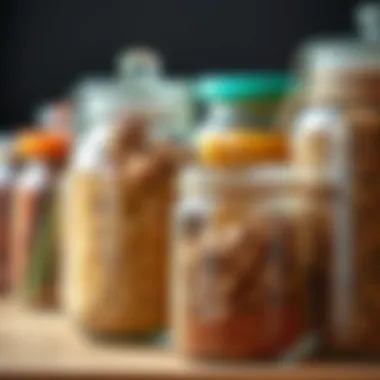
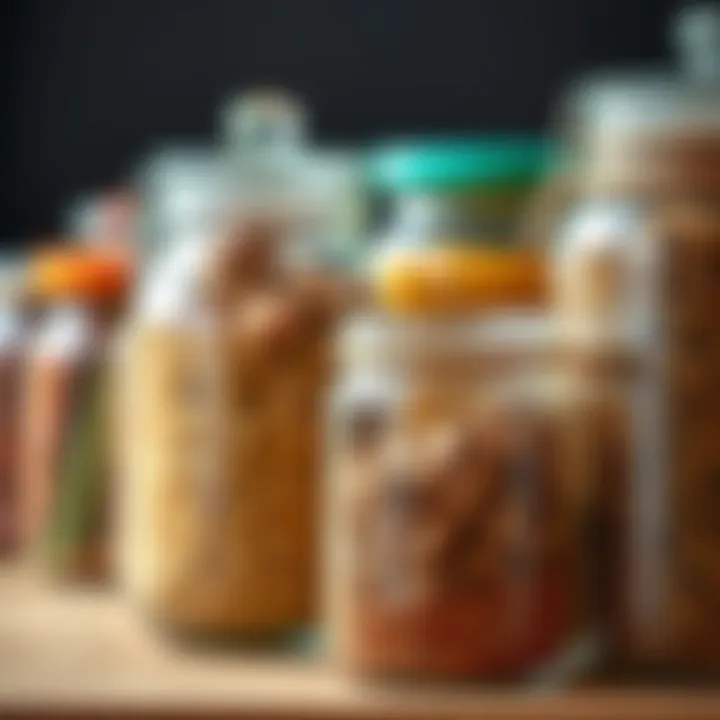
Intro
In recent years, the popularity of glass jars as a food storage solution has skyrocketed, catching the attention of homeowners, designers, and DIY enthusiasts alike. But what makes glass jars stand out in a world filled with plastic containers? This article dives into the multifaceted benefits of glass jars, examining not only their practical applications but also their undeniable aesthetic appeal. Beyond mere functionality, using glass jars contributes to an eco-friendly lifestyle and can beautifully enhance your kitchen decor.
This exploration goes way beyond just picking a jar off the shelf. It encompasses various types of jars, best practices for utilization, organization techniques, and maintenance practices. Moreover, it highlights the trend of repurposing glass jars, suggesting innovative ways to give them a new lease on life. Whether you're aiming to declutter your pantry or make a statement with your food storage solutions, understanding the ins and outs of glass jar usage is crucial. So, let’s embark on this journey to uncover everything you need to know about utilizing glass jars effectively.
Preface to Glass Food Storage
When it comes to preserving food, the containers we choose play a pivotal role. Glass jars have made a substantial comeback in modern kitchens. Their enduring appeal lies beyond mere aesthetics; they embody practicality, sustainability, and health consciousness. In this section, we will explore the significance of utilizing glass jars for food storage, outlining the benefits, considerations, and the context that has shaped their resurgence in popularity.
Historical Context of Food Storage
Historically, food preservation techniques have varied widely, adapting to technological advancements and cultural practices. In ancient times, communities relied on techniques such as drying, salting, and fermenting to extend the shelf life of their food. It wasn't until the 19th century that canning and glass preservation gained traction, driven by a burgeoning demand for long-lasting food supplies. The invention of glass jars not only represented a revolutionary change in storage methods but also reflected the era’s increasing interest in cleanliness and safety in food handling.
"What was once a simple necessity turned into an art form with the introduction of glass containers, allowing recipes and flavors to shine through in transparency."
With glass jars, the ability to see the contents inside fosters confidence in freshness, inviting users to maintain better inventory of their food supplies.
The Rise of Glass Jars in Contemporary Kitchens
Fast forward to today, glass jars have secured their place firmly on the shelves of contemporary kitchens. In our modern era, as concerns about sustainability and health rise, many turn to glass as a preferred storage solution. The evolution of consumer preferences, driven by a quest for healthier living, has prompted this revival. Homeowners and chefs alike appreciate that glass is non-porous and does not leach harmful chemicals into food, unlike some plastic containers.
Moreover, glass jars come in various shapes and sizes, enabling home cooks and designers to coordinate with their kitchen decor. Whether it’s the vintage Mason jar or more innovative designs like swing-top jars, the versatility of glass appeals to a broad audience. Furthermore, it allows for stunning visual appeal; clear containers showcase colorful ingredients and homemade goodies, making them as much a part of kitchen interiors as the appliances themselves.
In an age where aesthetics merge with functionality, glass jars tick all the boxes. The ongoing trend toward minimalism and sustainability represents just a part of why these jars deserve a closer look in the context of food storage. Their ability to marry practicality with beauty continues to capture the attention of DIY enthusiasts and designers alike.
Advantages of Glass Jars for Food Storage
In recent years, homeowners, designers, and DIY enthusiasts have turned to glass jars as more than just a storage solution–they’ve become a staple in modern kitchens and pantries. The advantages of utilizing glass jars for food storage go far beyond mere aesthetics or personal preference. Understanding their benefits lays a solid foundation for why these jars not only serve practical purposes but also enhance living spaces.
Durability and Versatility
Glass jars are surprisingly resilient given their perceived fragility. While it’s true that being made of glass can lead to concerns about breaking, high-quality jars are crafted to withstand both daily use and the rigors of time. Unlike plastic containers that may warp, stain, or become brittle, premium glass jars can last for years if not decades. They’re versatile, too; their uses span from preserving fruits and vegetables to storing homemade sauces and dry goods like pasta or grains.
Consider a large, beautiful mason jar filled with organic quinoa – not only does it keep the food fresher longer, it also becomes a decorative element in your kitchen. Glass jars can easily transition from pantry storage to a centerpiece on your kitchen island or dining table, giving them a unique dual purpose.
Non-Toxicity and Health Benefits
When it comes to food storage, health is a paramount concern. Glass jars are non-reactive and do not leach harmful chemicals into the food, unlike some plastics that may do so as they age or are subjected to heat. This makes glass the safer choice for those looking to store food without the specter of chemical contamination.
They also serve to keep food fresher due to their impermeable nature. Glass jars are typically air-tight, thwarting the entry of contaminants and providing an effective barrier against moisture. Thus, whether it's storing homemade sauces or preserving fruits, being able to maintain both flavor and nutritional value is a significant advantage.
"Using glass jars helps create a healthier environment in both kitchens and our bodies."
Aesthetic Appeal in Kitchen écor
Let’s face it; aesthetics play a role in every aspect of our homes. With their transparent allure, glass jars invite a visual connection between the food we consume and the containers that hold them. Displaying colorful ingredients like spices, dried fruits, or beans can turn an ordinary kitchen into a vibrant showcase.
Moreover, they can complement various design styles; from rustic farmhouse aesthetics to sleek modern looks, glass jars can enhance or contrast beautifully. By adding elements such as vintage labels or handcrafted wooden lids, homeowners can customize these jars to further reflect their personal style. One of the most alluring aspects of glass jars is how they can elevate the ambiance of a kitchen without any effort.
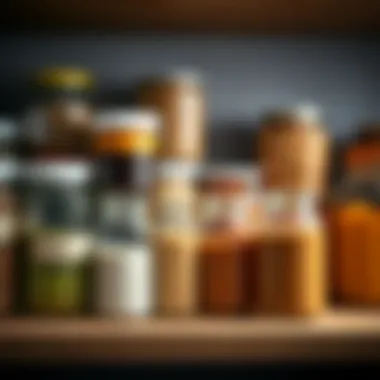
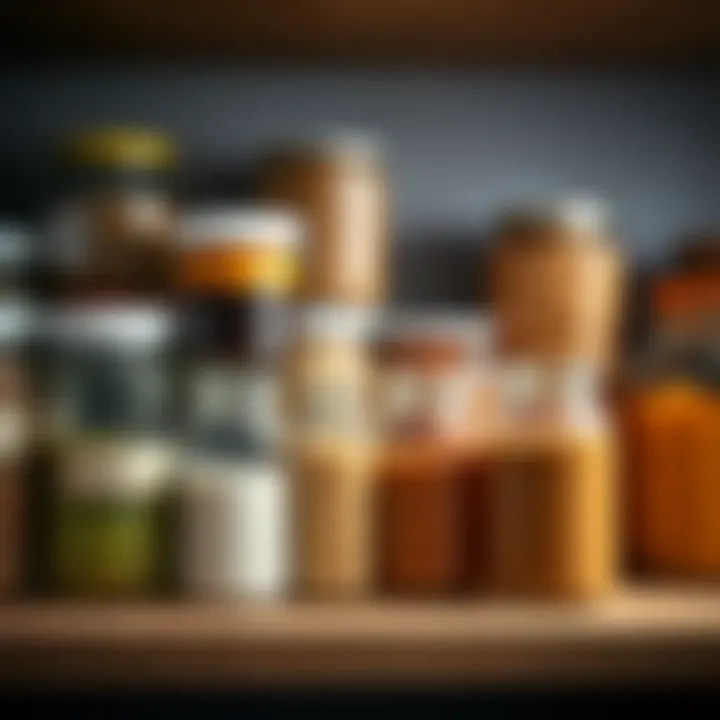
In a world increasingly focused on environmental consciousness and aesthetic coherence, glass jars prove to be an exceptional choice for food storage. Their durability, health benefits, and visual appeal work together, creating a symbiosis that resonates with both practicality and style. As we continue to embrace innovative storage solutions, the advantages glass jars contribute cannot be overstated.
Types of Glass Jars for Food Storage
Understanding the types of glass jars for food storage is crucial for making informed choices in the kitchen. Each type serves unique purposes, catering to different food items and storage needs. The right jar can enhance freshness, provide ease of access, and even contribute to the aesthetic of your pantry. Here, we’ll take a closer look at three popular types of glass jars and discuss their features, benefits, as well as considerations when selecting the best option for your kitchen.
Mason Jars: A Classic Choice
Mason jars have been around for over a century, and their popularity doesn't seem to wane. These jars are renowned for their reliability and versatility. Often used for canning, they are perfect for long-term storage of fruits, vegetables, and even grains. Their standard sizes make them stackable, saving precious space in a cluttered kitchen.
One of the key advantages of Mason jars is their airtight seals. The metal lids ensure that contents remain fresh, making them ideal for preserving items like jams and pickles. Aside from practical usage, Mason jars can also serve as stylish serving vessels at parties or casual meals, adding a rustic charm to your table setting. In fact, many opt to fill them with colorful ingredients like pasta, nuts, or herbs as part of their kitchen decor.
However, it's important to note the fragility factor. Although durable, these jars can break if mishandled. Additionally, while they are great for many uses, they may not be ideal for liquid-heavy foods without some preparation. Still, their multifaceted nature easily makes Mason jars an indispensable item in many kitchens.
Swing Top Jars: Functionality and Style
Next up, swing top jars are an elegant blend of function and fashion. These jars, often seen in bakeries and upscale kitchens, feature a ceramic or rubber seal that can be easily opened and closed. This design offers a convenient user experience while ensuring the contents are securely stored.
Swing top jars are fantastic for storing dry goods like cookies, candies, or herbs. Their unique closure mechanism means there’s no screwing to fuss with, providing quick access when you’re in the middle of preparing a meal or snack. Plus, their attractive design can elevate the look of any countertop or kitchen shelf.
However, with beauty often comes a bit of a price tag. They may not be as budget-friendly as other options, but their longevity and visual appeal often justify the expense. Also, you must ensure that these jars are placed in areas where they are less likely to be knocked over, as their glass structure could lead to spills and breakage.
Airtight Containers: Ensuring Freshness
Then there are airtight containers, specialized glass jars designed specifically for preserving food freshness. These containers come with a robust sealing mechanism, often utilizing silicone or rubber, that creates a perfect seal to keep air out. This feature is essential for items like grains, coffee, and spices, which can easily lose their potency and flavor when exposed to air.
Using airtight containers provides a strong defense against moisture and pests, making them a wise choice for longer storage durations. For instance, if you want to keep your flour or sugars from getting clumpy or attracting unwanted guests, an airtight container is the way to go.
Another notable point is their versatility across various food types. Whether you’re storing snack mixes for movie night or transitioning summer herbs into winter staples, these jars can accommodate a myriad of food items and adapt well in a well-organized kitchen. That said, it’s wise to research which specific containers best suit the items you intend to store, ensuring they meet your performance needs.
"Selecting the right type of glass jar for food storage is not just a matter of style; it directly impacts the longevity and quality of your stored goods."
Best Practices for Food Storage in Glass Jars
Utilizing glass jars for food storage is not just a trendy choice; it embodies a practical and thoughtful approach to preserving food quality and promoting a sustainable lifestyle. When done right, using glass jars can enhance the longevity of your food items while keeping your kitchen organized and visually appealing. Properly harnessing the potential of glass jars requires understanding of specific elements that lead to beneficial storage practices.
Selecting the Right Jar for Each Food Type
Choosing the right glass jar truly matters in maintaining the freshness and integrity of your food. Different foods exhibit varying storage needs, and here’s where selection comes into play.
- Dry Goods: Foods like rice, pasta, and beans need jars that can resist moisture while keeping pests at bay. A standard wide-mouth mason jar works wonders here. Its ample opening allows easy scooping and pouring, making cooking convenient.
- Condiments and Liquids: For liquids like sauces or oils, swing-top jars provide an easy access point. They create a tight seal that prevents spillage while allowing the contents to be used with comfort.
- Fermented Foods: Glass jars with airlock systems are perfect for fermentables. They create the right environment for fermentation to occur while keeping unwanted bacteria out.
Selecting the jar might seem straightforward, but understanding the properties of your food can elevate your storage game significantly.
Cleaning and Maintenance Guidelines
Once you've selected your jars, maintaining them is crucial for safe food storage.
- Washing: It’s best to wash glass jars in warm, soapy water to ensure all residues are removed. Use a soft sponge to avoid scratching the glass. For jars that previously held sticky items, soaking them helps ease the cleaning process.
- Sanitization: For a thorough clean, especially when storing homemade products, consider a rinse in 5% vinegar solution or a light bleach solution (1 tablespoon per gallon of water), followed by a thorough rinse and let them air dry. This method ensures all potential bacteria are dealt with.
- Storage Conditions: Store glass jars in a cool, dark place, ideally in a pantry or cupboard, to avoid exposure to heat that can weaken glass and compromise stored food.
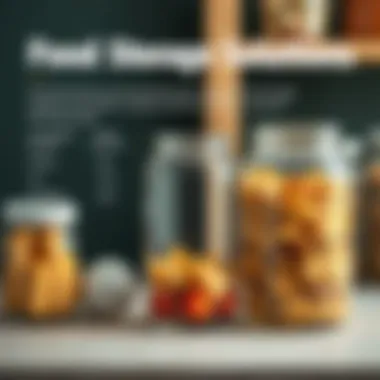

Taking care of your jars not only prolongs their life but also guarantees that your food will stay as fresh as possible.
Labeling for Organization
A touch of organization goes a long way in the kitchen, and labeling serves as a cornerstone of keeping your food storage effective.
- What to Label: It’s essential to label jars with the food type and the date when it was stored. This information helps in tracking freshness and planning meals accordingly.
- Label Types: You can use reusable chalkboard labels or simple masking tape and a permanent marker for a straightforward approach.
- Aesthetic Considerations: For those keen on aesthetics, consider using decorative tags or even printable labels that match the vibe of your kitchen décor. A good-looking label can elevate not just functionality but also the overall feel of your culinary space.
"An organized kitchen is a happy kitchen."
Keeping your jars labeled will not just save time during meal prep but lessen the chances of having any food wastage, thus leading to more mindful consumption.
In summary, applying these best practices will enhance the benefits of using glass jars significantly. Selecting the right jar for each food type, maintaining clean jars, and keeping them organized will contribute greatly to an efficient and effective food storage solution.
Environmental Considerations
In today's world, where environmental sustainability is becoming more crucial than ever, the role of food storage methods cannot be overlooked. Glass jars not only serve as efficient storage options but also contribute positively to eco-friendly practices. Understanding their environmental impact helps consumers make informed decisions and encourages a shift towards sustainable living. This section highlights the specific elements regarding the sustainability of glass compared to plastic, as well as the recycling aspects and lifespan of glass products.
Sustainability of Glass vs. Plastic
When we talk about sustainability, the debate often centers around glass and plastic. Glass jars shine brightly in this regard for a host of reasons.
- Reusability: Unlike plastic, which can often be designed for single use, glass jars are built to last. With a little care, they can be reused countless times without degrading in quality or safety.
- Material Composition: Glass is made from natural materials such as sand, soda ash, and limestone, which are abundant and less harmful to extract. In contrast, plastic is derived from petrochemicals which contribute to greenhouse gas emissions during extraction and production.
- Biodegradability: Glass does not decompose in the environment as plastic does. While glass can shatter and become waste, it won’t emit harmful substances into the soil or water, meaning it poses significantly less risk to the ecosystem.
Despite these advantages, one must take into account the energy-intensive process involved in glass production. Nonetheless, the long-term benefits of glass usage typically outweigh the initial environmental costs.
Recycling and Lifespan of Glass Products
Recycling glass jars effectively is another feather in the cap for their environmental credentials. Most glass containers can be recycled indefinitely without losing quality or purity, which is a major plus for sustainability efforts.
- Recycling Process: When you properly recycle glass, it avoids landfills where it can last for thousands of years. The recycling process saves energy and raw materials, as recycled glass can be molten down and reshaped into new glass products.
- Consumer Participation: Engaging in recycling programs varies by region, but many localities offer curbside recycling services or specific drop-off centers. Homeowners can significantly contribute to recycling efforts by ensuring their glass jars are clean when placing them in recycling bins.
- Lifespan of Glass: A bonus is that glass jars have a potentially infinite lifespan. If maintained properly, they can be utilized for generations, making them not only a smart choice today but a lasting investment. According to studies from environmental organizations, the durability of glass retains less waste and promotes sustainable consumption.
"Each recycled glass jar avoids a future trip to a landfill and conserves this planet’s resources."
Repurposing Glass Jars Beyond Food Storage
In the realm of sustainability and creativity, the journey of glass jars does not end once they're emptied of their culinary contents. Instead, it opens the door to a myriad of possibilities that breathe new life into these functional vessels. This section underscores the significance of repurposing glass jars, not only as a means of reducing waste but also as a way to infuse personality into our homes.
Given the increasing trend toward eco-conscious living, the act of reusing glass jars aligns perfectly with this ethos. Transforming what might otherwise be discarded into something both practical and aesthetic speaks volumes about one's commitment to a greener planet.
Crafting and DIY Projects
Glass jars make for the perfect canvases in the world of crafting and DIY projects. They provide a blank slate that can be altered, painted, and reimagined. You can create candle holders, terrariums, or even personalized gifts that reflect individual tastes. For example, an empty spaghetti jar can become a rustic farmhouse vase with a bit of twine and some country-style paint.
Here are some popular project ideas:
- Candle Holders: With just a bit of wax and a wick, you can turn jars into beautiful candle holders. Add some essential oils for fragrance and you have a perfect centerpiece for your dining table.
- Planters: Small plants like succulents thrive in glass jars, allowing you to create indoor gardens. Simply add soil and a drainage layer with pebbles and watch your mini-garden grow.
- Gift Jars: Layer ingredients for cookies or cakes in a jar, top with a decorative lid, and add a label. It's a thoughtful gift that's both unique and made from the heart.
Each project not only promotes creativity but contributes to personalizing your space while being friendly to the environment.
Home écor Utilization


Repurposing glass jars can extend into home décor, serving as eye-catching accents throughout various settings. From the kitchen to the living room, the aesthetic value of these jars can transform a mundane space into a cozy nook.
Think about how glass jars can be used in creative display arrangements. For instance, placing assorted jars filled with colorful marbles, seashells, or potpourri on a shelf can add a touch of whimsy. This clever arrangement not only declutters but also invites conversation.
Here are ways to utilize glass jars as décor:
- Lamps: With a little electrical work, a glass jar can be transformed into a stylish lamp. A simple bulb inside creates an inviting glow that softens any room.
- Wall Art: Attach jars to a wooden board and fill them with flowers or twinkling LED lights for a stunning wall feature.
- Storage Solutions: Use jars in your kitchen or bathroom as chic storage solutions—think cotton balls, spices, or rice—while maintaining easy access and a decorated look.
"Repurposing glass jars transcends mere utility; it touches the essence of creativity and sustainability,"
By utilizing glass jars creatively, homeowners can enhance their living spaces while embracing sustainability. This approach not only reflects personal style but also supports the global conversation about eco-friendly practices. Whether for crafting or décor, the potential for repurposing glass jars is limitless and worth exploring.
Potential Challenges of Glass Food Storage
When it comes to food storage, glass jars shine for many reasons, but they are not without their drawbacks. Understanding the challenges associated with glass jars can help homeowners, designers, retailers, and DIY enthusiasts make informed decisions. This section explores specific concerns related to weight and fragility and the cost implications of glass storage, offering a balanced view that highlights both the benefits and the potential drawbacks.
Weight and Fragility Concerns
One of the most apparent challenges of using glass jars for food storage is their weight. Glass can be heavy compared to plastic, which may not seem like a big deal for a jar of sugar or flour, but a collection of multiple jars can quickly add up. For individuals with mobility issues or small kitchen spaces, maneuvering these jars can be cumbersome.
Moreover, the fragility of glass is another critical factor to consider. A simple drop can shatter a glass jar, leading to not only a mess but also potential injury. This fragility means that while glass offers many advantages, such as non-toxicity and aesthetic appeal, it demands careful handling. Homeowners may wish to weigh these fragilities against the benefits, contemplating their lifestyle and storage needs.
"A break here or there can turn a delicious meal prep into a kitchen catastrophe, so it’s wise to stay conscious of what’s in your cabinets."
This consideration nudges some towards using a mix of glass for decorative storage and plastic for practical, everyday use. It allows one to maintain the aesthetic while keeping functionality front and center.
Cost Considerations
When diving into the financial side of glass food storage, the initial investments can be steeper compared to their plastic counterparts. Glass jars can range widely in price based on their size, design, and features (such as airtight seals). While this might be a worthy investment given their durability and aesthetic, it still requires some financial planning.
Repeated purchases of cheap plastic storage solutions, which often wear out or become unusable, can add up over time. However, it's crucial to consider the longevity of glass. A well-maintained glass jar can last for years, often outliving its plastic rivals. This long-term durability thereby shifts the initial price scrutiny towards a more favorable light when seen over an extended period.
For those focused on sustainability, the higher price point may be less daunting. They might see glass as a way to contribute positively to the environment, reducing plastic waste in landfills. But for a young family or a budget-conscious homeowner, the upfront costs could be a deciding factor in the choice between glass and plastic. Evaluating personal values, long-term storage needs, and budget constraints becomes essential in navigating this decision.
In summary, while glass jars deliver many benefits that enhance food storage, addressing the potential challenges requires careful consideration of their weight, fragility, and cost. By doing so, individuals can better integrate glass storage into their kitchens in a way that balances benefits with practical realities.
Ending: The Future of Food Storage
As we journey through the ever-evolving landscape of kitchen management, the discourse surrounding food storage has become increasingly significant. This article has set the stage for understanding the myriad benefits that glass jars offer, not just as a practical solution but as a sustainable lifestyle choice. In the age of convenience, where quick fixes dominate, glass jars stand out as timeless vessels, marrying function with elegance. Their ability to maintain food freshness resonates well with both environmentally conscious consumers and culinary aficionados alike.
Embracing Modern Trends
In recent years, we've seen a resurgence of interest in sustainable practices. Embracing the use of glass for food storage aligns with modern trends that prioritize health and wellness. More homeowners are forsaking plastics that often leach chemicals, opting instead for glass that enhances both food safety and culinary presentation. The trend of "minimalist living" also plays a significant role here; a neatly organized kitchen with glass jars can serve as a statement in itself.
Moreover, the DIY culture has significantly expanded the realm of how glass jars can be utilized. No longer just vessels for canning, they're now variegated pieces in personalized storage solutions. From spice organization to salad dressing dispensers, the possibilities are vast. A simple glass jar can be your canvas, reflecting personal style while offering utility. With the touch of creativity, one will find themselves constantly reimagining how these jars fit into both food storage and aesthetics.
Informed Consumer Choices
Finally, the power to make informed consumer choices cannot be overstated. As we navigate the supermarket aisles, being selective about what we purchase extends beyond the nutritional label. Knowledge about the materials of our food storage solutions plays a critical role in long-term health and environmental welfare.
Glass jars, being non-toxic and fully recyclable, allow consumers to contribute towards reducing plastic pollution. However, it’s essential to look out for the quality of glass and the type of lid used, as even jars can vary in safety standards. Understanding these nuances ensures that one’s choice is not just a whimsical decision, but a well-rounded, educated selection in promoting food safety and environmental stewardship.
"Every jar tells a story, from its contents to its role in the kitchen; ensuring each choice supports both personal values and practical needs makes us wiser stewards of our environment."
Ultimately, the future of food storage lies in the integration of modern conveniences with sustainable practices. By embracing glass jars in our kitchens, we are encouraged to cultivate healthier habits while contributing to a more sustainable planet. Let’s cherish these versatile containers that carry not only food but the essence of mindful living into the future.















